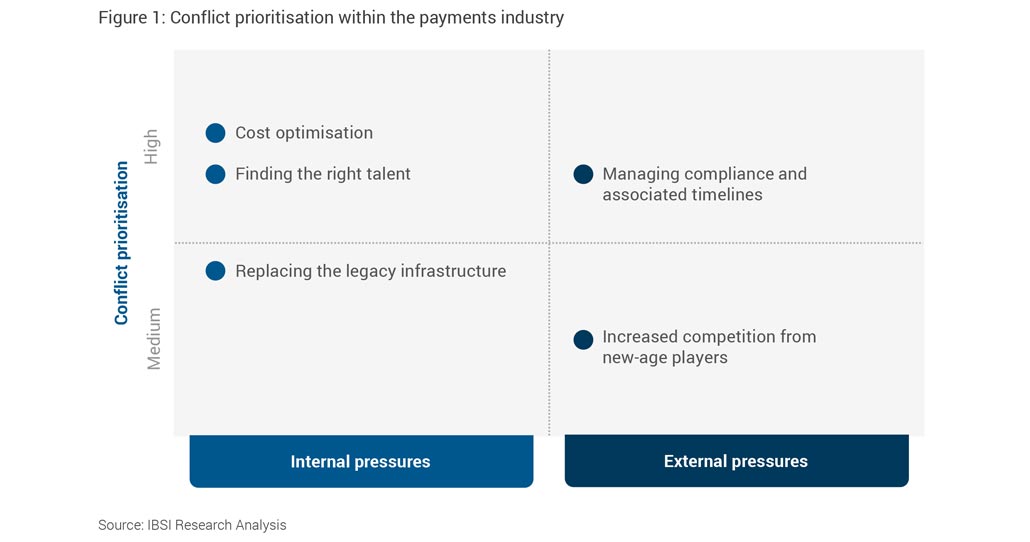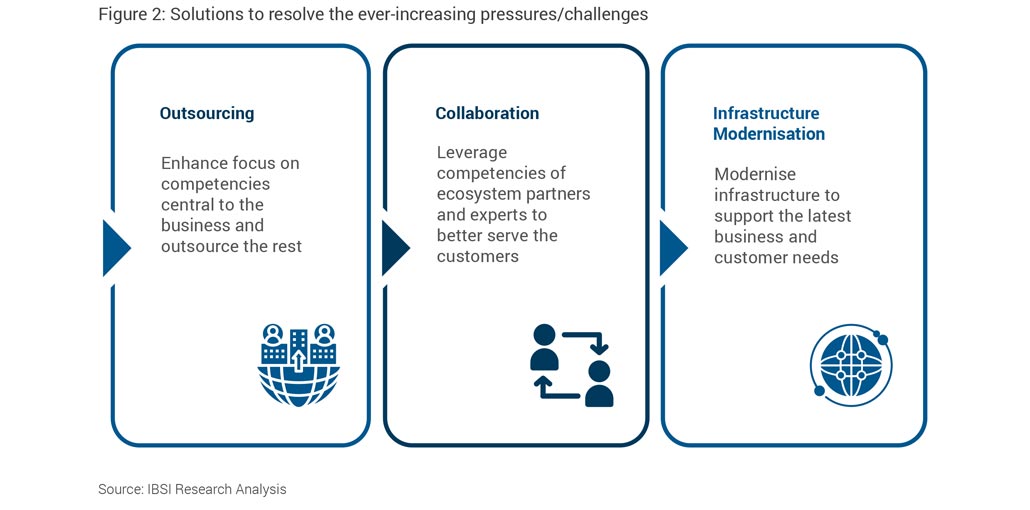Evolution of the payments landscape
Like other industries, the payments industry has been no stranger to various disruptions in terms of the surge in technological advancements and behavioural shifts across customer demographics. With business models already being challenged, the COVID-19 pandemic has impacted the industry adversely. As trade volumes declined by more than 13% in 2020, per the World Bank estimates, the COVID-19 aftershocks pushed the payments industry to adapt to multiple trends such as the rise in card payments and the increase in contactless channels.
Meanwhile, the velocity of regulatory and other mandatory changes are adding another layer to the already complex payments landscape. Regulators are advancing the Payment Services Directive 2 (PSD2)/ open banking mandate along with the European Payment Initiative (EPI) for a unified payment solution tailored for Europe. However, banks are reluctant, owing to various risks involved in sharing data and potential hefty penalties when breaching data protection regulations. These risks, coupled with fragmented compliance activities and differences between local and regional regulatory initiatives such as PRETA or STET in Europe along with multiple systems and schemes, further exacerbate banks’ operational and financial burden. A case in point being the emergence of several real-time payment schemes globally and the lack of interoperability.
Regardless of the issues mentioned above, regulations are expected to be reinforced in the near future as various fraudulent activities act as a tipping point for regulators to ensure customer safety.
At the same time, the industry is experiencing a mass switch towards contactless payments. In April 2020, 29 European countries increased their contactless payment limits, while the demand for mobile payments doubled in some countries. In France, cards are now seen as the preferred means of payments, while in the Netherlands, instant payments are becoming the new normal. The pressure on the payment providers is to offer real-time payments services 24 hours a day, seven days a week.
However, the increase in online transaction activities such as online shopping forced by the pandemic has propelled fraudulent activities. Unfortunately, it currently appears elusive to totally eradicate the risk of fraud. Still, payment providers continue to develop sophisticated fraud prevention and detection tools to reduce the incidence through artificial intelligence (AI) and robotic process automation (RPA).
With major incumbents struggling to prioritise their short-term and medium-term goals in the current volatile, uncertain, complex and ambiguous environment (VUCA), coupled with the surge in operational costs, the payment function within the banks is gradually becoming a commodity. The cost of ownership versus the benefits is becoming inversely proportional, leading to many banks to investigate outsourcing their payments function while concentrating on their unique selling propositions.
Major roadblocks for European incumbents in the payments domain
Rapid growth and colossal changes come with their own set of challenges and conflicts. When it comes to the payments industry, these conflicts affect both the incumbent banks and the overall payments ecosystem. Despite sincere efforts towards harmonisation and democratisation, the European payments system remains complicated at the moment. These headwinds and growing customer expectations have mired the industry with external and internal challenges and conflicts.

Internal challenges/pressures
- Inherent legacy technology – Banks and other financial service providers struggle to transform their current technology stack into a digital ecosystem due to the underlying complex legacy infrastructure. With today’s payments system driven by more advanced technologies such as application programming interfaces (APIs), AI and Big Data, incumbents lag in this adoption. Moreover, the unrelenting competition from the new-age agile Fintechs and other technology players is forcing banks to overhaul their infrastructure to provide an enhanced customer experience. According to a Marqeta report, 84% of payments executives blame legacy infrastructure for lack of innovation. Moreover, 85% believe that overhauling the existing infrastructure is the need of the hour.
- Facing the cost conundrum – Modernising the infrastructure is a cost-intensive affair, forcing banks to prioritise and choose between payment system modernisation or other technology initiatives. In a world where technology upgrades are imperative to success, incumbents struggle to control their bottom-line margins. A recent survey highlighted that 1 in 2 executives believe that reducing the cost of maintaining and managing legacy systems is a challenge.
- Scarcity of talent to improve legacy systems – While cost plays a crucial role in technology overhauling (especially in these times), lack of skilled resources also remains a significant roadblock. Banks face stiff competition from other industry players to attract and retain top talent in areas such as engineering, data science and designing.
External challenges/pressures
- Changing regulatory landscape and meeting the compliance timelines - Central banks across the globe have been working to improve payment ecosystems and move towards a cashless economy. Consequently, the markets have been subject to multiple regulatory reforms around open banking (e.g. PSD2), data protection, payment security, new payment schemes and standards (e.g. ISO 20022). Banks and payment service providers often struggle to navigate the complexities of different laws and regulations to ensure they meet local regulatory requirements across their markets of operation. Moreover, these firms are burdened with complying with looming deadlines, which are fast approaching. For instance, the T2-T2S consolidation project will end by November 2022, while ISO 20022 migration will be completed by November 2025.
- Rise in competition from new-age players and BigTechs - The competition from new-age Fintechs and BigTechs has been rising in the European landscape. While the first BigTech entered the payment landscape a decade ago, seven more have entered the European payments market by either obtaining licences or partnering with third parties post the PSD2 announcement.
As technology, talent and time become crucial enablers, banks need to figure out a dynamic one-stop shop solution that addresses their challenges and at the same time meets the ever-changing, growing consumer expectations.
Unlocking the potential
Banks and financial institutions (FIs) face numerous challenges, and a focused approach is required to confront those comprehensively. The first step is to identify the challenges, which will vary for individual FIs, and prioritise them according to business objectives.
Amidst increased regulatory activity and mandatory market change, managing compliance is one of the highest priorities, especially for European FIs. Cost optimisation, fraud reduction, and attracting skilled talent are a never-ending tussle. Outsourcing and collaboration can help banks tackle these high-priority tasks.

Outsourcing and mutualised, shared services bring in a host of advantages for banks. Banks can leverage a Payments-as-a-Service (PaaS) model to access the latest technology and offer innovative services to customers without worrying about costs related to infrastructure modernisation or their current technological capabilities and competencies. PaaS platforms, supported by dedicated payment specialists, will also be better equipped to facilitate alignment with new technological developments, regulatory requirements, or new market infrastructures, and enhance the future readiness of banks. Outsourcing payments processing may also be an impactful workaround for Tier 2/Tier 3 banks to deal with any shortage of skilled resources.
Shifting to a modern, cloud-based infrastructure can enhance banks’ resilience, agility, and scalability, while also reducing the total cost of ownership (TCO) and enabling the switch to operational expenditures Amidst increased regulatory activity and mandatory market change, managing compliance is one of the highest priorities, especially for European FIs. Cost optimisation, fraud reduction, and attracting skilled talent are a never-ending tussle. Outsourcing and collaboration can help banks tackle these high-priority tasks. (OPEX) from capital expenditures (CAPEX).
Furthermore, it can also enable banks to achieve significantly higher levels of operational efficiency through best-in-class straight-through processing and the dynamic resolution of processing exceptions, and provide the scalability to grow, capture new revenue streams and enhance the quality and range of client service provision without capacity or resource constraints.
The current environment has opened opportunities for banks and payment service providers alike to reevaluate and retool many ways of doing business. Why not take this opportunity to take a hard look at the current processes and technology partners? With the right platforms, technology and talent, incumbents and payments service providers will have the confidence and support to tackle the better (and busier) days ahead.
About the authors

Alastair McGill,
General Manager Data Control, Broadridge Financial Solutions
Alastair has more than 25 years’ management experience in the Technology and FinTech sectors and today leads Broadridge’s Payments and SWIFT business that serves more than a hundred clients around the world. The business has expanded rapidly and most recently announced a new Payments as a Service BPO offering for European institutions seeking to transform and modernise their payments infrastructure in response to market and regulatory changes.

Shitij Raj,
Senior Analyst, IBS Intelligence
Shitij has more than five years of experience in management consulting and global research with expertise in Payments and FinTech domain. His experience includes working with a variety of multinational and bluechip organisations in the Financial Services sector. He is a Senior Analyst at IBS Intelligence for global Financial Technology research, banking technology, supplier assessment and custom advisory services.
For more information, please contact the Broadridge team at global@broadridge.com